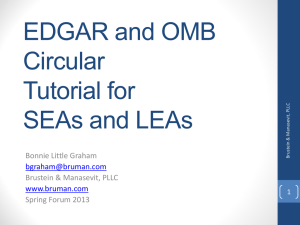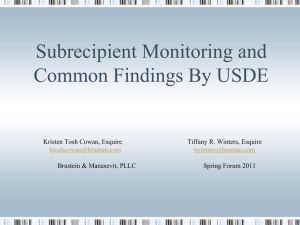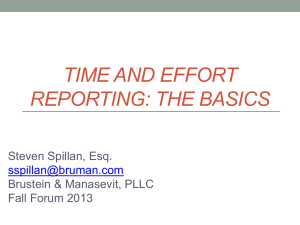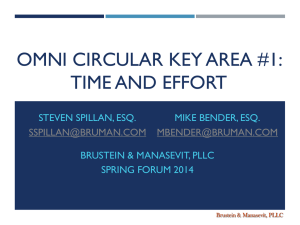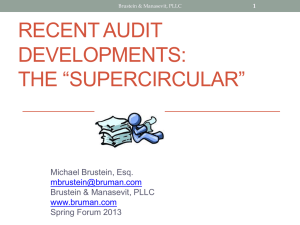Corrective action plans
advertisement
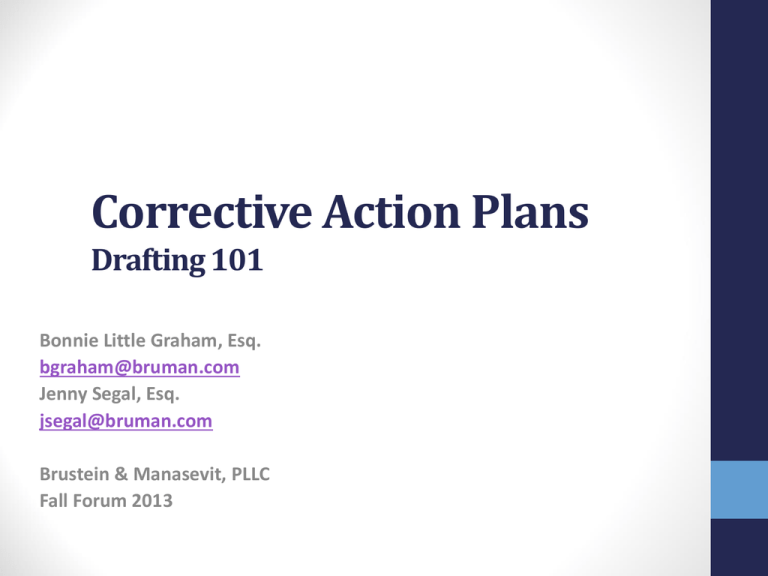
Corrective Action Plans Drafting 101 Bonnie Little Graham, Esq. bgraham@bruman.com Jenny Segal, Esq. jsegal@bruman.com Brustein & Manasevit, PLLC Fall Forum 2013 [N]ewly purchased items of equipment were not consistently entered into the property tracking system or, if entered, some of the items of equipment remained in the warehouses undelivered, were delivered to an incorrect location, or were misplaced or stolen. As of 1998, VIDE began to implement the corrective actions necessary to revamp its property management system as well as to correct other deficiencies in its administration of Federal grant programs. Progress was slow. As a result, VIDE was designated as a “high-risk” grantee and special conditions were imposed. Later, ED and VIDE entered into a compliance agreement that permitted VIDE to continue to receive funding while it implemented a structured plan to correct the administrative and programmatic deficiencies. Application of U.S. Virgin Islands Dept. of ED, Docket No. 05-04-R (Jan. 24, 2011). Brustein & Manasevit, PLLC Intro 2 1. When are corrective action plans necessary? 2. What needs to be in a corrective action plan? 3. Can the State/grantee require a corrective action plan from locals/subgrantees? 4. Can I use grant funds to pay for corrective actions? 5. How are corrective actions enforced? 6. Can I appeal required corrective actions? Brustein & Manasevit, PLLC Agenda 3 Brustein & Manasevit, PLLC WHEN ARE CORRECTIVE ACTION PLANS NECESSARY? 4 • Monitoring by ED or grantee • OIG audit • A-133 single audit • Performance data • Financial data • Internal review Brustein & Manasevit, PLLC Identifying Noncompliance 5 • Program Determination Letters • OIG Audit Report • Single Audit Report • Grant Award Notification – special conditions • Monitoring report • Self Assessment Brustein & Manasevit, PLLC Corrective Action Needed 6 Brustein & Manasevit, PLLC WHAT NEEDS TO BE IN A CORRECTIVE ACTION PLAN? 7 Corrective Action Plan, Example Audit Finding: • Auditors selected 261 payroll expenditures at four LEAs • 61 (23 percent) were inadequately documented Audit Recommendation: • Provide documentation in support of questioned costs, or return the funds to ED • Ensure training to all staff regarding federal requirements Brustein & Manasevit, PLLC • LEA did not maintain adequate time and effort documentation, questioned related costs 8 Corrective Action Plan, Example • Concurred with finding and recommendations • Asked to initiate audit resolution procedures regarding the questioned payroll expenditures • Provided plan for technical assistance and training to all LEAs regarding how to properly document time and effort (not only those reviewed by OIG) Brustein & Manasevit, PLLC SEA Response: 9 Corrective Action Plan, Example • • • • • February 18, 2011 – Draft OIG Audit Report March 4, 2011 – SEA Response to Audit Report April 11, 2011 – Final OIG Audit Report May 9, 2011 – SEA provides ED with plan for corrective action September 12, 2012 – SEA provides evidence of corrective actions • September 28, 2012 - Final Determination by ED Brustein & Manasevit, PLLC Timeline: • “No further corrective actions are required.” 10 • • • • • • Objective/activity (measurable) Timeline Identify person responsible Budget Data Deliverables Brustein & Manasevit, PLLC Corrective Action Plans 11 Corrective Action Plans Example • Finding: SEA’s current monitoring instrument and monitoring reports do not address adequately Title III use of funds and supplement not supplant issues. SEA does not distinguish that Title III funds should supplement the level of Federal, State and local public funds. Consequently, LEAs were supplanting Title III funds and using Title III funds for unallowable costs. Brustein & Manasevit, PLLC Monitoring Review by ED 12 SEA must ensure that its Title III monitoring activities focus on compliance with Title III fiscal and programmatic requirements, particularly in the area of ensuring LEAs are not supplanting Title III funds. Responsible Staff [Include position title], English Learner Office will make revisions to instrument; [Position title], Federal Program Office will implement revised instrument and provide necessary training Deliverables Due Date Revised monitoring plan; Revised monitoring instrument; Evidence of training and implementation. 11/30/13updated draft monitoring instrument provided for review; 1/31/14-legal reviews; 3/31/14-federal program office includes revised doc; 8/31/14train SEA program reviewers and LEAs Brustein & Manasevit, PLLC Activity / Implementation Steps 13 Corrective Action Plans Example • Financial Management • Procurement • Inventory Management • Time and Effort Brustein & Manasevit, PLLC • Significant issues; general grants management and administration 14 1. Hire outside consultant to conduct Risk Assessment, create compliant grants policies and procedures and training materials. 2. Staff Grants Compliance Office. 3. New processes for position coding. 4. Implement time and effort forms and protocols. 5. Deploy new Enterprise Resource Planning system. Responsible Staff [Position title, task assigned] Core group of staff identified and tasked with implementing corrective actions. Deliverables Due Date 1. RFP; Selected Contractor 2. Draft Risk Assessment, Input 3. Final Risk Assessment 4. List of policies 5. Policies (draft, final) 6. Detailed procedures (draft, final) 7. Related forms 8. Training materials 9. Evidence of training 10. Adjustments to policies, procedures May 2010RFP; Oct 2010Vendor selected; Nov 2010Contract; July 2010Draft Risk Assessment; Sept 2010Final Risk Assessment; July 2011Draft policies … Brustein & Manasevit, PLLC Activity / Implementation Steps 15 Critical – CAP in place at time of visit, even if implementation will be in the FUTURE Brustein & Manasevit, PLLC Audit or Monitoring Review Scheduled? 16 Example – Time and Effort •Numerous employees paid from program they previously (no longer) work on Brustein & Manasevit, PLLC •LEA – Self assessment 17 Example – Time and Effort (cont.) • Remedy and Corrective Action or • Reassign employees back to prior program Brustein & Manasevit, PLLC • Change payment sources to reflect current assignment AND • Reimburse improperly charged program 18 Example – Time and Effort (cont.) • Review all employees (federally paid) to assure alignment • Correct the misalignments • Assign specific individual/office responsibility for future reviews • In-service training Brustein & Manasevit, PLLC • Corrective Action Plan - FUTURE 19 • Over-promise • Under-promise • Unrealistic timeframe • Does not address the issue Correcting noncompliance can be a lengthy process, measured in years rather than months Brustein & Manasevit, PLLC Corrective Action Plan 20 Brustein & Manasevit, PLLC CAN THE STATE/GRANTEE REQUIRE A CAP FROM LOCALS/SUBGRANTEES? 21 • EDGAR 80.40; 74.51 • Grantees are responsible for managing the day-to-day operations of grant and subgrant supported activities. Grantees must monitor grant and subgrant supported activities to assure compliance with applicable Federal requirements and that performance goals are being achieved. Grantee monitoring must cover each program, function or activity. Brustein & Manasevit, PLLC Authority 22 • EDGAR 80.12; 74.14 • A grantee or subgrantee may be considered “high risk” if: • History of unsatisfactory performance • Is not financially stable • Has management system that does not meet EDGAR standards • Has not conformed to terms and conditions of previous awards • Is otherwise not responsible Brustein & Manasevit, PLLC Authority 23 Brustein & Manasevit, PLLC CAN I USE GRANT FUNDS TO PAY FOR CORRECTIVE ACTIONS? 24 Paying for Corrective Actions • Allowable? • Legal expenses required in the administration of Federal programs are allowable. • Costs related to cooperative audit resolution are allowable • Allocable? • Activity is allowable under multiple programs, agency has discretion in determining which programs may be charged. 34 C.F.R. 76.760 • Agency can make “business decision” regarding what combination of funds would be applied to a function or activity that benefits two or more programs. Implementation Guide for OMB Circular A-87, Q&A 2-16 • Example: Cross-cutting grants management policies and procedures manual Brustein & Manasevit, PLLC • Necessary and reasonable 25 Brustein & Manasevit, PLLC HOW ARE CORRECTIVE ACTIONS ENFORCED? 26 Whenever the Secretary has reason to believe that any recipient of funds under any applicable program is failing to comply substantially with any requirement of law applicable to such funds, the Secretary may— • withhold further payments under that program, • issue a complaint to compel compliance through a cease and desist order of the Office, • enter into a compliance agreement with a recipient to bring it into compliance • take any other action authorized by law with respect to the recipient. Any action, or failure to take action, by the Secretary under this section shall not preclude the Secretary from seeking a recovery of funds • GEPA, 20 USC 1234c Brustein & Manasevit, PLLC Enforcement - ED 27 • • • • Withholding approval of application Withholding of funds Reimbursement with special conditions High risk designation Brustein & Manasevit, PLLC Enforcement - Grantees 28 Compliance Agreement • Continue to receive federal funding • Clear requirements and deadlines Cons • Heightened federal oversight • Deadlines • Inflexible • Expensive Brustein & Manasevit, PLLC Pros 29 Withholding of funds • Reasonable notice of intent to withhold and opportunity for a hearing with an impartial hearing officer. 20 U.S.C. 1232c(b)(2); 20 U.S.C. 1234d(b). • Withhold until satisfied there is no longer a failure to comply. • Suspending: • SEA must provide notice to the subgrantee and allow it 15 days to show cause why the suspension should not take effect. 20 U.S.C. 1232c(b)(2). • If the subgrantee does not show cause, SEA may suspend funds for 60 days Brustein & Manasevit, PLLC • Withholding: 30 Reimbursement with Special Conditions • ED and Grantees have discretion to impose special conditions For example: SEA could reimburse 80% of each Federal draw upon receipt of the summary reports and detailed lists, and then reimburse the remaining 20% after sampling certain expenditures and verifying detailed supporting documentation (such as time and effort documentation supporting payroll charges and requisition requests, purchase orders, contracts, receiving documents, invoices and canceled checks for non-payroll charges). Is this reimbursement scheme “withholding”? See Maryland OIG Audit Report Brustein & Manasevit, PLLC • Grantees are responsible for ensuring all expenditures are lawful (including subgrantees’ expenditures) and for ensuring all findings of noncompliance are resolved. 34 CFR 80.40(a). 31 High Risk Designation • Payment on a reimbursement basis; • Withholding authority to proceed to the next phase until receipt of evidence of acceptable performance within a given funding period; • Requiring additional, more detailed financial reports; • Additional project monitoring; • Requiring the grantee or subgrantee to obtain technical or management assistance; or • Establishing additional prior approvals. • 34 CFR 80.12 • 34 CFR 74.14 Brustein & Manasevit, PLLC • After placing the grantee/subgrantee on high risk, special conditions or restrictions that correspond to the high risk condition must be imposed. Such special conditions or restrictions may include: 32 Brustein & Manasevit, PLLC CAN I APPEAL REQUIRED CORRECTIVE ACTIONS? 33 • Disallowance v. Corrective action • GEPA permits an appeal of a disallowance decision • No appeal of corrective actions • A-133, _.315(c) “If the auditee does not agree with the audit findings or believes corrective action is not required, then the corrective action plan shall include an explanation and specific reasons.” Brustein & Manasevit, PLLC Appeal 34 Appeal – Disallowance • Compromise authority: In certain circumstances, ED may compromise the amount claimed under GEPA if the grantee/subgrantee demonstrates “the practice that resulted in the disallowance decision has been corrected and will not recur.” 34 C.F.R. 81.36 • Grantback: In certain circumstances, ED may offer a grantback of up to 75% of the recovered funds if the “practices or procedures of the recipient that resulted in the violation have been corrected.” 20 U.S.C. 1234h(a). • Equitable offset: Remedy available to grantees and subgrantees to prevent the recovery of sustained audit liabilities. Case law establishes that evidence of appropriate corrective actions is an equitable factor in support of the application of equitable offset. Brustein & Manasevit, PLLC Impact of Corrective Action on Recovery Amount 35 Brustein & Manasevit, PLLC THE “SUPER” CIRCULAR ON CORRECTIVE ACTIONS 36 Cooperative Audit Resolution • Corrective Action means action taken by the auditee that: • Corrects identified deficiencies; • Produces recommended improvements; or • Demonstrates that audit findings are either invalid or do not warrant auditee action Brustein & Manasevit, PLLC • “Federal agencies offering appropriate amnesty for past noncompliance when audits show prompt corrective action has occurred.” 37 38 Brustein & Manasevit, PLLC • After significant audit findings in 2008 (for the audit period 2004-2006), the SEA and LEA began working with ED to address systemic internal control issues highlighted in the audit report. • The final Program Determination Letter was issued in March 2013. All questioned costs were barred by statute of limitations. • Many findings were fully resolved, although some corrective actions were still required to address specific audit concerns: • Proof that LEA properly codes employee activities as supplemental or regular work activities and only charged Title I for insurance benefits of regular work duties; • Evidence of trained employees responsible for allocating salaries between programs Brustein & Manasevit, PLLC For example… 39 For example… • Improved policies and procedures and strengthened internal controls to: (1) maintain adequate documentation to support disbursement of federal funds; (2) procedures for obtaining quotes for procurements; (3) documentation supporting procurements. Training on procedures. • Lack of procurement documentation an issue for several years • Procedures and internal controls to prevent unallowable expenditures, including improper payments and overpayments and to promptly collect amounts due. • Problem escalating in the three audit reports • Policies and procedures and internal controls regarding subrecipient monitoring for the 21st Century Community Learning Centers Program. • Grantee argued formal monitoring procedures are “best practice” only Brustein & Manasevit, PLLC • ED issued a Program Determination Letter regarding three single audits with monetary determinations of $2.6 million and required corrective actions: 40 Brustein & Manasevit, PLLC Questions? 41 This presentation is intended solely to provide general information and does not constitute legal advice. Attendance at the presentation or later review of these printed materials does not create an attorney-client relationship with Brustein & Manasevit, PLLC. You should not take any action based upon any information in this presentation without first consulting legal counsel familiar with your particular circumstances. Brustein & Manasevit, PLLC Disclaimer 42
